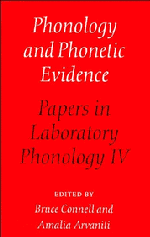Book contents
- Frontmatter
- Contents
- List of contributors
- Acknowledgments
- 1 Introduction
- I Features and Perception
- II Prosody
- III Articulatory Organization
- 15 Prosodic patterns in the coordination of vowel and consonant gestures
- 16 “Where” is timing? Comments on Smith
- 17 Asymmetrical prosodic effects on the laryngeal gesture in Korean
- 18 On a gestural account of lenis stop voicing in Korean: comments on Jun
- 19 A production and perceptual account of palatalization
- 20 An acoustic and electropalatographic study of lexical and postlexical palatalization in American English
- 21 What do we do when phonology is powerful enough to imitate phonetics? Comments on Zsiga
- 22 The influence of syntactic structure on [s] to [∫] assimilation
- 23 Assimilation as gestural overlap: comments on Hoist and Nolan
- 24 Orals, gutturals, and the jaw
- 25 The role of the jaw — active or passive? Comments on Lee
- 26 The phonetics and phonology of glottalized consonants in Lendu
- 27 Lendu consonants and the role of overlapping gestures in sound change: comments on Demolin
- Subject index
- Index of names
- Index of languages
22 - The influence of syntactic structure on [s] to [∫] assimilation
Published online by Cambridge University Press: 03 May 2011
- Frontmatter
- Contents
- List of contributors
- Acknowledgments
- 1 Introduction
- I Features and Perception
- II Prosody
- III Articulatory Organization
- 15 Prosodic patterns in the coordination of vowel and consonant gestures
- 16 “Where” is timing? Comments on Smith
- 17 Asymmetrical prosodic effects on the laryngeal gesture in Korean
- 18 On a gestural account of lenis stop voicing in Korean: comments on Jun
- 19 A production and perceptual account of palatalization
- 20 An acoustic and electropalatographic study of lexical and postlexical palatalization in American English
- 21 What do we do when phonology is powerful enough to imitate phonetics? Comments on Zsiga
- 22 The influence of syntactic structure on [s] to [∫] assimilation
- 23 Assimilation as gestural overlap: comments on Hoist and Nolan
- 24 Orals, gutturals, and the jaw
- 25 The role of the jaw — active or passive? Comments on Lee
- 26 The phonetics and phonology of glottalized consonants in Lendu
- 27 Lendu consonants and the role of overlapping gestures in sound change: comments on Demolin
- Subject index
- Index of names
- Index of languages
Summary
Introduction
This paper is about the phonetic facts of assimilation, its phonological modeling, and the effects of syntactic structure on its occurrence. The emphasis is on the first two. In some respects the paper leads on from an earlier paper (Nolan, 1992) and the commentaries on it by Browman, Hayes, and Ohala. Section 22.2 will review some of the points in that paper, which dealt with place of articulation (POA) assimilation in stops. Section 22.3 will then take up some suggestions which arose in the commentaries; and this will lead in to the main part (section 22.4) of the current paper, which will present new work on POA assimilation, this time in fricatives rather than stops.
Place of articulation assimilation in stops
The work reported in Nolan (1992) starts from the question: “Does articulation mirror the discrete change implied by phonetic and phonological representations of assimilation?” For instance, in red car, does the /d/ at the end of red “change into” a /g/ as a phonemic, or even phonetic, transcription would imply? The experiments used pairs of sentences, such as:
(a) They di [dg] ardens for rich people.
(b) They di [gg]ardens for rich people.
where (a) provides a potential POA assimilation site at a word boundary -specifically an alveolar before a velar; and (b) provides a velar-velar control context. The basic instrumental tool used was electropalatography (EPG).
- Type
- Chapter
- Information
- Phonology and Phonetic EvidencePapers in Laboratory Phonology IV, pp. 315 - 333Publisher: Cambridge University PressPrint publication year: 1995
- 22
- Cited by



